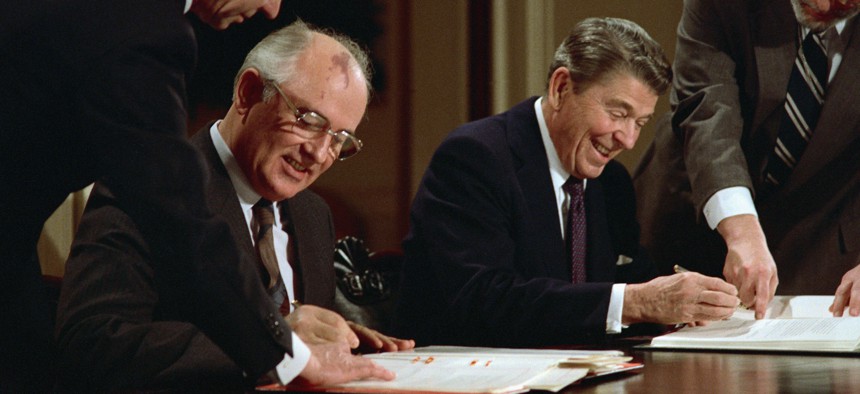
U.S. President Ronald Reagan and Soviet leader Mikhail Gorbachev signing the arms control agreement banning the use of intermediate-range nuclear missiles, the Intermediate Nuclear Forces Reduction Treaty, Washington DC, December 8, 1987. Getty Images / Bettmann
Slouching Towards Armageddon
As Cold War-type dangers return, we should restore the things that once pulled the world back from the brink.
As we begin year three of a global pandemic, evidence continues to mount that a period of historic global instability and economic disruption has exacerbated major-power tensions that are veering dangerously towards conflict. With bellicose rhetoric and military provocations increasing dramatically along the U.S.-Russia-China axis, the current era begins to bear an alarming resemblance to the darkest early days of the Cold War, when missteps and miscalculations created crises like the Berlin blockade of 1948, the Korean War of the early 1950s, and the Cuban missile crisis in 1962, pushing the major powers to the brink. Little wonder that the Bulletin of Atomic Scientists has set its Doomsday Clock to just one hundred seconds to midnight, the closest it’s ever been to Armageddon.
To reset the clock, the administration and Congress must rediscover a consensus on the looming threat, and begin rebuilding the strategic architecture of arms control and verification treaties, confidence-building and de-confliction protocols, and open lines of communication that kept the Cold War from turning hot for decades. Time is of the essence.
Just in recent weeks Russia has amassed more than 100,000 troops on its border with Ukraine, reportedly sent saboteurs into eastern Ukraine to potentially stage a “false flag” incident as a pretext for invasion, and likely launched a massive cyberattack on government websites in Kyiv. Before recently test-firing a new, nuclear-capable Zircon hypersonic cruise missile from a submarine, President Vladimir Putin even stressed that it could reach Washington, D.C., and “those who give the orders” in “five minutes.” That was the kind of veiled threat rarely heard from a Russian leader since Soviet leader Nikita Khrushchev told a gathering of Western leaders in 1956 that “We will bury you!”
Meanwhile, as the new year dawns in the Indo-Pacific, China has recently ramped up its threats and military coercion aimed at Taiwan, flying record numbers of warplanes into Taipei’s air defense zone and holding military exercises simulating an invasion of the island. Recently China also successfully tested a nuclear-capable hypersonic weapons system that caught the U.S. intelligence community by surprise. After U.S. satellites recently revealed two previously unknown Chinese missile “fields” with more than 200 silos for intercontinental ballistic missiles, the Pentagon warned that Beijing’s nuclear arsenal is on track to triple or even quadruple by the end of the decade, giving it a “first strike” capability for the first time.
With the United States, Russia, and China all in the midst of an aggressive modernizations of their nuclear weapons arsenals, the kind of runaway arms race that left the world awash in doomsday weapons at the height of the Cold War is not just a distant possibility – it has already begun. Unfortunately, this period of major power tensions also comes at a time when the carefully constructed Cold War architecture of strategic stability measures is near collapse.
To its credit, the Biden administration has noted this dangerous downward spiral, and has taken steps to try and stabilize a roiling geopolitical landscape. Confronted last year with the imminent sunset of New START – the last treaty limiting the size on the nuclear arsenals of the United States and Russia, which together possess 90 percent of the world’s nuclear weapons – Biden and Putin extended the treaty for the maximum five years. That gives negotiators critical breathing room to begin discussing a host of thorny issues that must be addressed in a follow-on treaty, to include the implication of new technologies such as hypersonic delivery systems; a much needed ban on kinetic anti-satellite weapons tests that befoul the space commons; and new norms for insuring cyberattacks are never used to target nuclear command-and-control and early warning systems.
The Biden-Putin summit in Geneva last summer, and a follow-on Strategic Stability Dialogue between U.S. and Russian negotiators, were important steps towards trying to lower the temperature and place guardrails around flash points. So was a virtual summit in November between Biden and Chinese leader Xi Jinping. But a threatened Russian invasion of Ukraine would reverse those gains.
The Biden administration will also soon release its Nuclear Posture Review, which arms control advocates hope will honor the president’s pledge to reduce the role of nuclear weapons in U.S. strategic doctrine. A good beginning would be a statement that the “sole purpose” of the U.S. nuclear arsenal is to deter or retaliate against a nuclear attack. The recent Joint Statement from the leaders of the five officially recognized nuclear weapons states (China, Russia, the United States, France and Great Britain) committing to “Preventing Nuclear War and Avoiding Arms Races” was another positive step, especially their affirmation that “a nuclear war cannot be won and must never be fought.” That phrase echoes the pledge taken by former President Ronald Reagan and Soviet leader Mikhail Gorbachev in 1985 that helped pave the way for an end to the Cold War arms race.
The Nuclear Posture Review debate also presents Congressional leaders with a critical opportunity. Given the pervasive climate of hyper-partisanship and distrust in Washington, D.C., many lawmakers today have little memory of the sustained bipartisanship that was necessary to build the foundation of strategic stability that kept the Cold War dormant for decades. Congressional leaders should seize that opportunity to rekindle the consensus-building spirit of the bipartisan Arms Control Observer Group of the 1980s, the Nunn-Lugar Cooperative Threat Reduction Program of the 1990s, and the National Security Working Group of the 1990s and 2000s – all of which fostered greater cooperation on strategic issues within Congress, and between Congress and the executive branch.
The world is enduring a period of profound instability as it copes with a global pandemic, one of the worst economic shocks since the Great Depression, and the worst tensions in major power relations since the early days of the Cold War. These crises come at a time when the treaties and multilateral institutions that are the foundation of the international order and strategic stability are wobbling. In the past such periods of deep economic distress and geopolitical tensions have given rise to dark political forces, and are ripe for confrontation among nation-states. History will not judge kindly American political leaders who were complicit in adding a runaway nuclear arms race to that volatile mix.
James Kitfield is a senior fellow at the Center for the Study of the Presidency & Congress, and a three-time recipient of the Gerald R. Ford Award for Distinguished Reporting on National Defense.
